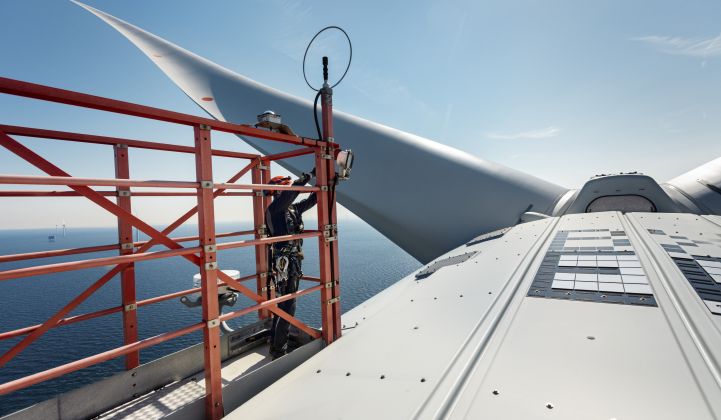Offshore wind power could be a lot cheaper if the generators inside the turbine nacelles were lighter. The U.S. Department of Energy is here to help.
DOE recently made available up to $8 million for four projects aiming to “develop more efficient, smaller, and lighter-weight generators.” According to DOE, the prospective designs could result in 50 percent smaller and lighter generators, which could reduce the levelized cost of wind energy by as much as 25 percent.
With an eye toward the mammoth wind turbines coming online by the mid-2020s — GE announced plans in March 2018 to commercially deploy a 12-megawatt offshore turbine in 2021 — the Energy Department wants to nudge manufacturers to build generators that can more easily be hoisted atop hubs topping out more than 100 meters above the waterline.
Project teams led by ABB, WEG Electric Corporation, American Superconductor and General Electric Global Research, respectively, were each to receive up to $400,000 to design a wind turbine generator capable of scaling to a capacity of 10 megawatts or more. ABB subsequently confirmed to Greentech Media it will not pursue the research project it had planned under the DOE grant, but the other three remain active.
After an initial one-year conceptual design phase, DOE will select one of the projects to receive up to $6.4 million for the construction of a scaled prototype. The full research program is expected to last four years.
Next-gen direct drive generators
The teams involved in the DOE-funded research project are developing direct-drive technologies for their planned high-efficiency, lighter generators.
Direct-drive machines generate electricity without using a gearbox, resulting in avoided maintenance. “Having all of those moving parts makes the gearbox one of the highest-maintenance parts of a wind turbine,” noted the DOE in a recent blog post.
According to Aaron Barr, senior consultant at Wood Mackenzie Power & Renewables, the current generation of direct-drive wind generators “has reached technical and commercial maturity,” accounting for 26 percent of the wind turbines installed on land and 50 percent installed at sea globally in 2018.
But direct-drive turbines come with their own tradeoffs. Current designs rely on permanent magnets that require expensive, heavy rare earth elements. This in turn increases the weight of direct drive generators relative to those used in geared wind turbines.
WEG Electric Corporation plans to develop a lightweight generator designed both to use less rare earth materials than conventional geared turbines and to be integrated into its existing platform. ABB had planned to develop a generator that uses a magnet cooling system for use in either geared or direct-drive turbines as large as 15 megawatts.
The other two project teams — American Superconductor and GE — are developing superconducting generators expected to greatly reduce the need for rare earth materials.
GE’s proposed ultra-light low-temperature superconducting generator relies on lessons learned from the company’s decades-long magnetic resonance imaging (MRI) work. The goal is a solution customized for offshore wind turbines larger than 12 megawatts.
“Superconducting electric machines aren’t really anything new. What is new is some of the cryogenic technologies that have evolved over the years for MRI we can now bring to electric machines to make them practical,” David Torrey, GE’s team leader, told Greentech Media in an interview.
He added, “To the extent you can raise the magnetic field, you can produce more power with less heat, making your generator more efficient.”
Superconducting generators' path to market
According to WoodMac's Barr, superconducting generators have been researched for years but manufacturers have yet to develop a commercial prototype.
Wood Mackenzie estimates that the technology is at least a decade from commercialization, with deployment likely to come in next-generation 15-megawatt or larger offshore wind turbines.
“However, this will require an intensive R&D effort from OEMs, supply chain partners, and government-funded research,” Barr said.
That's the reasoning behind the Department of Energy’s push to jump-start R&D in this space.
Direct-drive and superconducting generators have the most market potential at sea, where the reduced size and weight of the next-generation generators envisaged by DOE are likely to have the greatest impact.
“Offshore turbines are expected to be 60 percent direct-drive by 2025,” said Barr.
DOE sees high-efficiency, lightweight generators as one way to reduce the weight and cost of towers and foundations for both bottom-fixed and floating offshore turbines.
“As we look to the future with floating offshore wind platforms to access wind resources where the water is too deep for conventional foundations, lightweighting while maintaining high efficiency becomes even more important,” wrote the DOE’s project team.
Just don’t expect the DOE-backed generator designs to take over the market in the near term.
“The design cycle for offshore turbines is very long, due to the massive scale of the technology, significant supply chain investment, and high risk that dictates extensive validation periods,” said Barr.
“The DOE-funded research is unlikely to be applied commercially on the next generation of offshore wind turbines until 2030 or later.”
However, GE’s Torrey was optimistic that earlier deployment might be possible.
“We consider the MRI technology to be quite mature right now. Barring any unforeseen surprises, I think we can certainly have something deployed well before 2030.”




